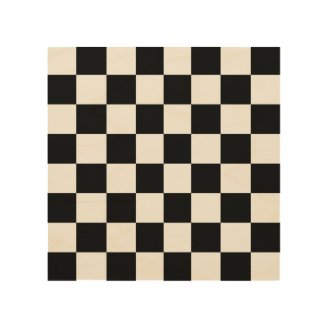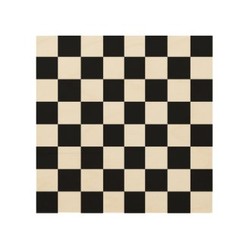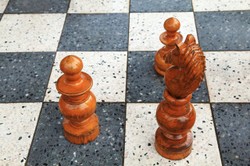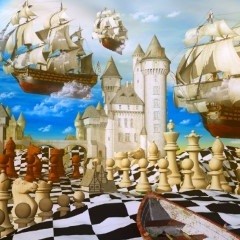he mechanics of moving chess pieces is mastered after playing a few games. The ability to win at chess is another matter. It is often said that one must see several moves in advance to win at chess. But there are often many options for moves. Seeing several moves does not mean knowing what an opponent will choose, it means forcing the opponent's choice.
Studying chess requires breaking the game down into the beginning game, the middle game, and the end game. While it may sound wrong, start your study of chess with the middle game. The strategies of the opening and the middle game are the same, and the tactics of the middle game apply whenever you can utilize them. Study both strategy and tactics.
The study of the beginning is not that different from the study of the middle game, except much of the work has already been done by others and published. Learn from a good book. And if that book also explains why things are done you will also improve your middle game.
When there are few pieces, the approach is much different. The end game is one of the most difficult parts of the game to master.
Know the rules. It is inconsequential if you have a great material advantage if you allow your opponent to find a place where there is no move. If your opponent is not in check, the game is a draw. Always be careful.
In tournament play be mindful of the clock. Even if you can force checkmate in one or two moves, once your time expires you lose.
It is recommended that you purchase a minimum of five good chess books, one giving the official rules, one on modern chess openings, a tactics book, a strategy book, and an end game book. The details are so great that one book is insufficient.






















 Multivariable Calculus: Gradient, Divergence, and Curl18 days ago
Multivariable Calculus: Gradient, Divergence, and Curl18 days ago
 UAPs, Formerly UFOs, If They Are Real How Can We Explain Their Arrival to Earth?19 days ago
UAPs, Formerly UFOs, If They Are Real How Can We Explain Their Arrival to Earth?19 days ago
 Polar Coordinate System21 days ago
Polar Coordinate System21 days ago
 Aurora Can Disrupt Electrical Devices And Even the Grid?22 days ago
Aurora Can Disrupt Electrical Devices And Even the Grid?22 days ago



Comments
When opening the queen's bishop pawn one plays a very closed position, with little the opponent can do but eventually trade off pieces. It is called Caro-Khan defense, and the person playing the black pieces, the one who moves second, can move the queen's bishop pawn in response to the king pawn being moved two by the player of the white pieces. I like it when playing against a stronger player. A draw is the best result against a stronger opponent. Most other defenses involve the king pawn to move two, but the stronger opponent probably has well studied all possibilities. I also like the French defense against a weaker opponent, pawn to king 3 instead of king 4 against a king pawn opening. It also closes the position, but the position eventually opens with the stronger player in great strategic position.
Look at Caro-khan in a chess opening book and also study the French defense. When I played many liked the Sicilian defense, but Bobby Fisher had success with it only because he was more advanced than many others. It worked for him, but is too difficult for others.
blackspanielgallery, Thank you for practical information, pretty pictures and product lines.
In particular, I appreciate the association of your examples and explanations regarding games, rules and strategies with available, esteemed, workable books.
Your subheading Chess Openings indicates that "There are only two pieces that should ever be moved first, the king pawn or the queen pawn, with the exception of the queen's bishop pawn if you are playing for a draw."
What would the opponent do to indicate that he/she recognized the queen's bishop pawn opening as alerting him/her to a draw?
I should mention that a chess program or a chess computer can substitute for an opponent, and often can be set to different levels of expertise. This is useful in not becoming discouraged when starting out. At first select a low level. Move up when success is frequent. That way you can improve.
I do not recall my age, but I too was young. Ir helps if more than one person is available, for this game requires two to be played. My brothers also learned young.
The younger that you learn to play,the better. I learned at age 11.
Good, it helps with seeing cause and effect and visualizing moves mentally to determine what long range consequences to actions will be.
BSG
Our 9 year old grandson is learning to play. He is enjoying it.
Playing requires understanding modus tollens, modus pones, disjucntive syllogism, and transitivity, and avoidence of the fallacy of the inverse and the fallacy of the converse. These logic rules in turn develop a significant thought process. Hence, the chaining of sequences of these rules helps one think in a logical manner to a greater depth than otherwise. And it is fun.
Getting to a high standard in chess requires the ability to focus a large amount of mental energy and aggression Into a confined activity.
BSG
Thank you for posting this. I know all the moves, as taught to me by all my brothers but the strategies defeat me.
About 30 years ago, I paid for my 2 sons to have Chess lessons after school and they both maintain that these Chess lessons were the best out-of-school activity they ever did in terms of transferable skills.
I wish I were better at the game.